Creativity Explored is one of the most significant art education centers and little-known exhibition spaces in the San Francisco Bay Area. It is committed to empowering and promoting people with developmental disabilities through art education and an on-site exhibition program (begun in 2001), which is an integral component of the center’s quest to develop and nurture working artists by advocating a more expanded and inclusive redefinition of contemporary art.
Founded in 1983 by civic-minded social reformers Florence Ludins-Katz and Elias Katz, Creativity Explored represents and embodies a wide range of social and aesthetic issues. These remain largely under-theorized and art historically marginalized and have only fairly recently begun to be formulated. These issues are still in need of being significantly addressed.
Currently, Creativity Explored is presenting Mind Place, an exhibition organized by staff art instructor Leeza Doreian, which is ostensibly concerned with “exploring the psychology of place … through representations of imaginary and physical worlds in the work.”
The exhibition features a variety of predominantly two-dimensional multimedia works presented to explore the “psychological experience of place” in order “to lead[s] the viewer on a journey to ethereal environments that are physical yet based in the mind.”
The more than two dozen artworks included in Mind Place by artists Ian Adams, Jay Herndon, Camille Holvoet, Laron Bickerstaff, Kathy Wen, and Marilyn Wong aim to “challenge traditional viewership by expanding visual depictions of a place into the subjective territory of a ‘mindscape.’”
While the the issue of what or who constitutes “traditional viewership” is hardly undertaken, what is clear is the title Mind Place is open to interpretation and is capable of conjuring an almost limitless array of visual, material, and psychic possibiities, based on sources of inspiration, personal associations, and fantasy constructions of the artists.
Indeed, the invocation of a concept such as “mind place,” by nature of its lack of definition as an identifiable entity or location, is open to a range of visual elements that are alegorically capable of standing in for a multitude of constructed “spaces” that might exist in an area designated as a “mind place.”
This idea may help explain the variety of visual utterances in the current exhibition, and the pictorial articulations of what, for the artists, may inhabit that “space.” Here, perhaps the most recognizable images are those of the facade of Mission Dolores (2018), Girls Dormitory When I First Went to The Hospital (2015), and a series of ferris wheel images by Camille Holvoet.
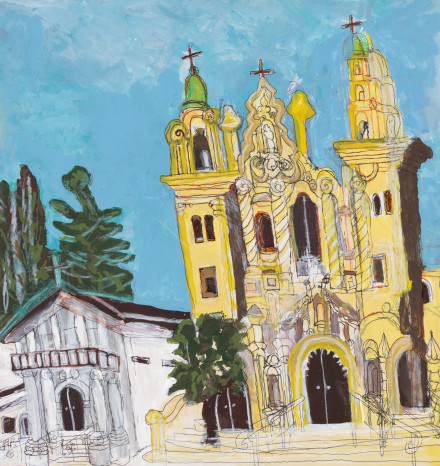
Camille Holvoet’s Mission Dolores, 2018. All Artworks © Creativity Explored, LLC . All Rights Reserved.
Holvoet’s Tinkertoy Ferris Wheel (2012), relates a basic iconic structure that informs the various symbolic depictions of ferris wheels that occupy Holvoet’s pictorial spaces, anchored by titles that identify them as particular times and places, such as Midnight Ferris Wheel in Seattle (2015) and Seattle Ferris Wheel with Iron Gates (2016).
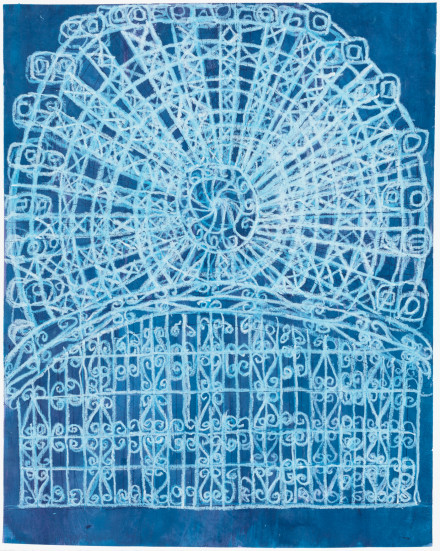
Camille Holvoet’s Seattle Ferris Wheel With Iron Gates, 2016. All Artworks © Creativity Explored, LLC . All Rights Reserved.
In these cases, the images are related by the structure of a circle attached by lines/spokes to a hub at the certer, anchored to an inverted “V” form that serves as the base for the various ferris wheel representations. This iconic form appears as solitary black lines against a white background, a white silhouette against a black color field, and in landscape settings — reminders of the somewhat creative arbitrariness of visual language systems in the construction of memories and meanings.
Ian Adams seems to favor the invocation of abstract juxtapositions of areas of color and the use of a title/text to bring forth associations of places like Antartica (2016), Namibia (2017), and Angola (2018), as well as phenomena in nature such as Sunset (2016).
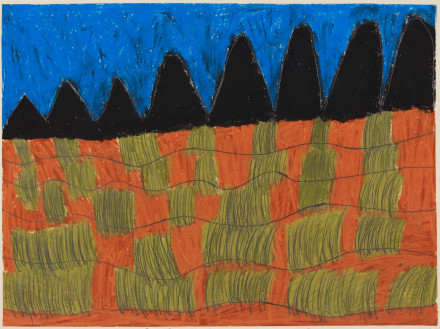
Ian Adam’s Namibia, 2017. All Artworks © Creativity Explored, LLC . All Rights Reserved.
Similarly, Kathy Wen prefers abstraction, and in particular, diagonal patterns housed in a horizontal grid structure with solid shapes and hovering forms that integrate the various horizontal areas to create images that speak of imaginary phenomena based and inspired by nature, in works such as Iceberg (2017), Rock and Ocean (2018), and Butterfly Sunset.
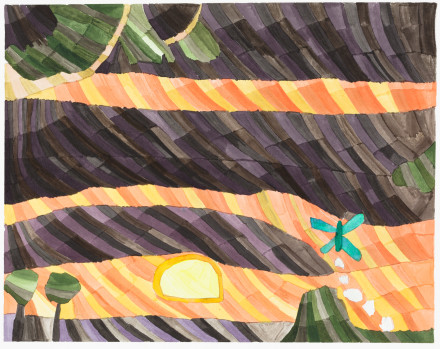
Kathy Wen’s Butterfly Sunset, 2018. All Artworks © Creativity Explored, LLC . All Rights Reserved.
ARTISTS AS SOCIAL ACTORS
Artists Jay Herndon, Laron Bickerstaff, Kathy Wen, and Marilyn Wong favor utilizing areas of color, gestural lines, and highly individual marks to create dense patterns that occupy the pictorial spatial planes as metaphors for their subjective mind places.
In the images, a “mind place” is formulated as a collection of associations and attachments, articulated within spatial settings created by the individual artists. Here, the visual language and texts on display speak of the individual artists as social actors whose identity formation is based in physical interactions with a world they inhabit and which they construct for themselves, through their art practices.
In this context, on view are evidentiary traces of the artists’ engagements with various material and art historical discourses, presented as a transformative vehicle for relating memories and addressing personal identifications within an ambiguously open-ended engagement with places — real and imagined — that are realized through specific cognitive processes and individual choices, and articulated through a constellation of symbolic utterances, formal vocabularies, and modes of aesthetic signification, to address highly personal psychic universes.
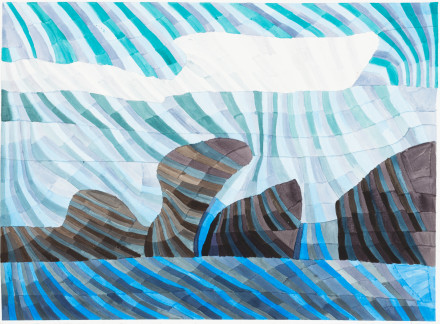
Kathy Wen’s Rock and Ocean, 2018. All Artworks © Creativity Explored, LLC . All Rights Reserved.





